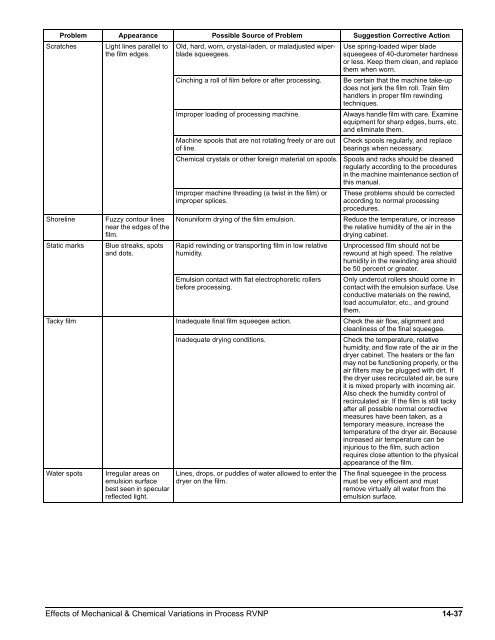Effects of Mechanical and Chemical Variations in Process ... - Kodak
Effects of Mechanical and Chemical Variations in Process ... - Kodak
Effects of Mechanical and Chemical Variations in Process ... - Kodak
Create successful ePaper yourself
Turn your PDF publications into a flip-book with our unique Google optimized e-Paper software.
Problem Appearance Possible Source <strong>of</strong> Problem Suggestion Corrective Action<br />
Scratches Light l<strong>in</strong>es parallel to<br />
the film edges.<br />
Shorel<strong>in</strong>e Fuzzy contour l<strong>in</strong>es<br />
near the edges <strong>of</strong> the<br />
film.<br />
Static marks Blue streaks, spots<br />
<strong>and</strong> dots.<br />
Old, hard, worn, crystal-laden, or maladjusted wiperblade<br />
squeegees.<br />
Use spr<strong>in</strong>g-loaded wiper blade<br />
squeegees <strong>of</strong> 40-durometer hardness<br />
or less. Keep them clean, <strong>and</strong> replace<br />
them when worn.<br />
C<strong>in</strong>ch<strong>in</strong>g a roll <strong>of</strong> film before or after process<strong>in</strong>g. Be certa<strong>in</strong> that the mach<strong>in</strong>e take-up<br />
does not jerk the film roll. Tra<strong>in</strong> film<br />
h<strong>and</strong>lers <strong>in</strong> proper film rew<strong>in</strong>d<strong>in</strong>g<br />
techniques.<br />
Improper load<strong>in</strong>g <strong>of</strong> process<strong>in</strong>g mach<strong>in</strong>e. Always h<strong>and</strong>le film with care. Exam<strong>in</strong>e<br />
equipment for sharp edges, burrs, etc.<br />
<strong>and</strong> elim<strong>in</strong>ate them.<br />
Mach<strong>in</strong>e spools that are not rotat<strong>in</strong>g freely or are out<br />
<strong>of</strong> l<strong>in</strong>e.<br />
Check spools regularly, <strong>and</strong> replace<br />
bear<strong>in</strong>gs when necessary.<br />
<strong>Chemical</strong> crystals or other foreign material on spools. Spools <strong>and</strong> racks should be cleaned<br />
regularly accord<strong>in</strong>g to the procedures<br />
<strong>in</strong> the mach<strong>in</strong>e ma<strong>in</strong>tenance section <strong>of</strong><br />
this manual.<br />
Improper mach<strong>in</strong>e thread<strong>in</strong>g (a twist <strong>in</strong> the film) or<br />
improper splices.<br />
These problems should be corrected<br />
accord<strong>in</strong>g to normal process<strong>in</strong>g<br />
procedures.<br />
Nonuniform dry<strong>in</strong>g <strong>of</strong> the film emulsion. Reduce the temperature, or <strong>in</strong>crease<br />
the relative humidity <strong>of</strong> the air <strong>in</strong> the<br />
dry<strong>in</strong>g cab<strong>in</strong>et.<br />
Rapid rew<strong>in</strong>d<strong>in</strong>g or transport<strong>in</strong>g film <strong>in</strong> low relative<br />
humidity.<br />
Emulsion contact with flat electrophoretic rollers<br />
before process<strong>in</strong>g.<br />
Unprocessed film should not be<br />
rewound at high speed. The relative<br />
humidity <strong>in</strong> the rew<strong>in</strong>d<strong>in</strong>g area should<br />
be 50 percent or greater.<br />
Only undercut rollers should come <strong>in</strong><br />
contact with the emulsion surface. Use<br />
conductive materials on the rew<strong>in</strong>d,<br />
load accumulator, etc., <strong>and</strong> ground<br />
them.<br />
Tacky film Inadequate f<strong>in</strong>al film squeegee action. Check the air flow, alignment <strong>and</strong><br />
cleanl<strong>in</strong>ess <strong>of</strong> the f<strong>in</strong>al squeegee.<br />
Inadequate dry<strong>in</strong>g conditions. Check the temperature, relative<br />
humidity, <strong>and</strong> flow rate <strong>of</strong> the air <strong>in</strong> the<br />
dryer cab<strong>in</strong>et. The heaters or the fan<br />
may not be function<strong>in</strong>g properly, or the<br />
air filters may be plugged with dirt. If<br />
the dryer uses recirculated air, be sure<br />
it is mixed properly with <strong>in</strong>com<strong>in</strong>g air.<br />
Also check the humidity control <strong>of</strong><br />
recirculated air. If the film is still tacky<br />
after all possible normal corrective<br />
measures have been taken, as a<br />
temporary measure, <strong>in</strong>crease the<br />
temperature <strong>of</strong> the dryer air. Because<br />
<strong>in</strong>creased air temperature can be<br />
<strong>in</strong>jurious to the film, such action<br />
requires close attention to the physical<br />
appearance <strong>of</strong> the film.<br />
Water spots Irregular areas on<br />
emulsion surface<br />
best seen <strong>in</strong> specular<br />
reflected light.<br />
L<strong>in</strong>es, drops, or puddles <strong>of</strong> water allowed to enter the<br />
dryer on the film.<br />
The f<strong>in</strong>al squeegee <strong>in</strong> the process<br />
must be very efficient <strong>and</strong> must<br />
remove virtually all water from the<br />
emulsion surface.<br />
<strong>Effects</strong> <strong>of</strong> <strong>Mechanical</strong> & <strong>Chemical</strong> <strong>Variations</strong> <strong>in</strong> <strong>Process</strong> RVNP 14-37
















